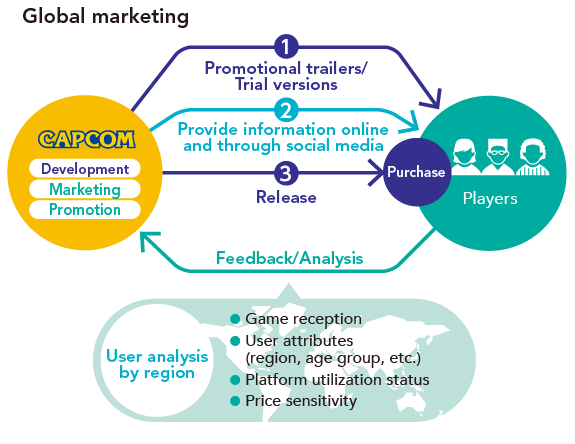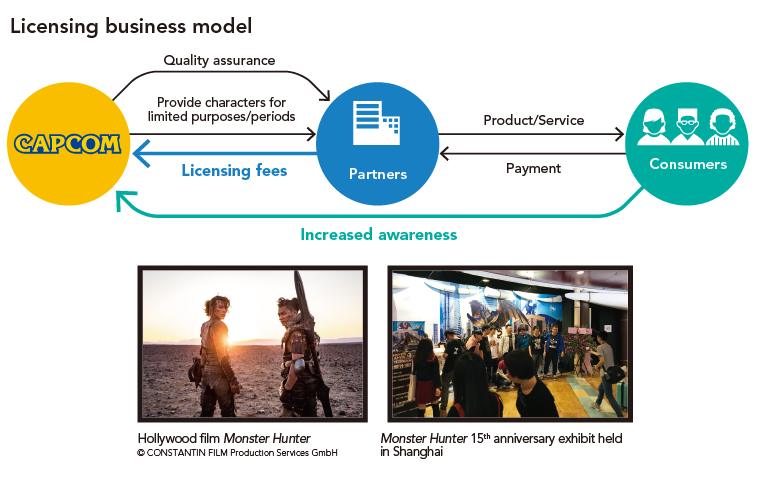- Value Creation Story (PDF)
- CEO
Commitment - Growth
Strategies - Financial Strategy
- Latest
Creative Report - Corporate Oversight

Our digital strategy is
leading us to our goal of becoming a digital content
company whose scope goes beyond games.
Haruhiro Tsujimoto
President and
Chief Operating Officer (COO)
I have been involved in the game industry for more than 35 years, and it has always been moving forward with great speed, but the global game software market has seen remarkable growth in recent years with a 141% growth rate over the last five years and an expected growth rate of 37% over the next five years. Behind this is the growth of digital sales in the Consumer home video game market and the globalization of the market, including mobile content. At Capcom, we are actively promoting a growth strategy that focuses on the Consumer home video game market, and our medium-term management goal is to achieve increased operating income each fiscal year.
We have adopted a digital strategy as we work to achieve our medium-term goal, and by maximizing use of the Internet as a sales channel, we are strengthening global long-term sales of game software. As we do this, we cannot forget that the traditional B2B business model in the game industry is now shifting to a B2C model. Getting closer to our users through digital marketing that makes use of our websites and social media will change the efficiency of our business dramatically.
As our digital strategy comes to fruition and we expand our game sales volume globally, my vison for the future is to see Capcom becoming one of the world’s leading digital content companies with our brand’s content going beyond the boundaries of games, such as with our esports and licensing businesses, and receiving worldwide recognition.
I will now explain the path we have started along that will lead us to this vision of Capcom in the near future.
Growth Strategy1
Digital content
Promote a digital strategy using our flagship IPs to bring us within reach of 30 million units in sales annually
Growth Strategy2
Esports
Continue investments with a long-term view, aiming to cultivate this new area of entertainment
Growth Strategy3
Licensing business
Become a digital content company with a scope beyond games

Digital content
Promote a digital strategy using our flagship IPs to bring us within reach of 30 million units in sales annually
Achieve long-term sales globally by further increasing the digital ratio in our core Consumer sub-segment
It stands to reason that the Consumer sub-segment is the core of our business and the source of our content creation. As a result of our improved profitability and progress in our recurring revenue model due to our proactive measures to popularize digital sales in recent years, our operating margin, which at one time had sunk into the single digits, is gradually improving and reached the 40% level by the fiscal year ended March 2020.
The market is expected to grow by 52% to $53.2 billion by 2024, which will likely further increase the digital sales ratio. Considering these circumstances, Capcom will continue releasing high-quality content underpinned by a world-leading development system in the next fiscal year and beyond. We will also use strategic pricing measures to address a broad range of user needs over the long-term in an effort to reach 30 million units in annual sales of software in the near future and continue growing that number.
The Head of Development Discusses Strategy
Measure 1 Steady annual launch of core IP in global markets
The steady release of new high-quality titles is a prerequisite for the changes we are making to our business structure, such as digitalization and globalization. Since Capcom restructured in 2013, we have been using our “60-month map,” which is our medium term title portfolio map, in tandem with our “52-week map,” which manages the annual assignments of our developers, establishing a mechanism for the timely allocation of our roughly 2,300 developers (as of June 30, 2020) to the titles that require their skills. This has allowed us to continue releasing major titles each fiscal year contributing to stable growth.
In addition, one of our strengths has been the fact that our most famous brands, such as Street Fighter and Resident Evil are also very popular overseas. Foreseeing market globalization, we released Monster Hunter: World (referred to as MH:W herein) as a strategic title in the Monster Hunter series in 2018. The title received worldwide acclaim and has sold a record 16.1 million units (as of June 30, 2020). Moreover, most of the titles we released thereafter employ the same meticulous MH:W quality and digital strategy resulting in strong sales.

However, we have not yet amassed enough developers for our future growth. We will continue to hire more than 100 new graduates and combine that with the hiring of seasoned mid-career professionals in priority fields to utilize our dormant IPs in addition to our existing IPs. This is a necessary measure for our long-term growth along with the creation of entirely new IPs, such as Pragmata, which we announced in June 2020.
Measure 2 Increased profitability and long-term sales globally with digitalization
Here I will explain our digital strategy, a central pillar in our growth strategy. We feel the main advantages of digital sales are (1) improved profitability due to package production cost reductions and avoidance of inventory risk, (2) additional earning opportunities and long-term sales of catalog titles, which is a sales opportunity that was not available at physical retail shops, and (3) marketization of emerging regions where the distribution of game consoles was difficult. These items brought a major transformation to the game business.
The strategy originated in 2013, before current game consoles (PlayStation 4, etc.) were launched, after I learned that these game consoles would have constant internet connectivity. I knew a major change was coming to the game business and we established strengthening our digital adaptability as a priority strategy. Seven years have now past, and our digital sales, which were 5.2 billion yen in the fiscal year ended March 2013, have grown more than eight times to 42.6 billion yen in the fiscal year ended March 2020. During this time, our Consumer sub-segment improved significantly in profitability.
Digitalization increased earnings for each title, as mentioned above, but it also carries the further advantages of long-term sales and globalization. In the past, performance in the Consumer sub-segment was largely dependent on whether or not Capcom had released a new hit title that year, but now, once a high-quality new title is released, it contributes to earnings for 3-5 years. In addition to that, in package sales, second-hand distributors dominated sales of the last 35 years of Capcom’s content assets, but because we are now able to offer them online at lower prices, they have become a steady source of earnings for us. Today, earnings in the Consumer sub-segment are comprised of some 200 titles each fiscal year. Meanwhile, from the users’ perspective, digital has the substantial advantage of being available at the time you want it, and the digital ratio is rising each year, even for new titles. For example, new release Resident Evil 3 has demonstrated a digital ratio of nearly 50% even at launch.
In recent years, PC platform versions have also increased their contribution to digital sales. We are now able to sell in countries and regions that far exceed the conventional console market, and we have analyzed that there is strength in expanding sales in emerging regions, such as Asia, South America, Eastern Europe, and the Middle East. I think that there is great potential for future growth in this area and have designated PCs a priority platform.
We will continue promoting these digital strategies in the next fiscal year and project achieving record high net digital sales of 45 billion yen. As there is still room for growth in pipeline expansion, long-term sales, and in global markets, we expect the digital sales ratio to rise to 80-90% in the medium-term and believe that the Consumer sub-segment profitability will continue to increase while we make further progress in our recurring revenue model.
Measure 3 Generate demand with pricing measures based on digital marketing
Next I will explain how digital has made the game business more efficient. For a long time, we have been focusing on using the most advanced internet technology. This is because in the near future digital natives will be the primary consumers, so for a luxury item such as games it is extremely important that we meet users on their terms and utilize digital communication.
Therefore, in order to both digitalize marketing and strengthen communication within the company, we have established the Global Marketing Meeting, where management and global department heads meet each quarter to formulate a marketing plan. As a result, since launching MH:W in 2018, management, development and business have integrated, and utilized Capcom’s websites and social media presence to improve the quality of our titles in line with users’ needs while establishing a suitable pipeline to purchasing digital versions, enabling us to institute a system that will expand sales.

At present, in terms of long-term sales and globalization, we are prioritizing detailed and flexible pricing measures, such as limited-time sale offers that consider the needs of each individual region and user demographic. At the end of 2019, we strategically lowered the price of the major titles released in the previous fiscal year by more than 50%, which succeeded in generating more than double the sales of the same period in the previous year.
Another positive example is the long-term sales of MH:W. More than two years have passed since its release in January 2018, but as a result of maintaining sales while gradually lowering the price, its cumulative sales volume has exceeded 16 million units; more than half of which were sold in the second year or later. The lowest price it has sold for thus far is approximately 15 dollars, but its development costs have already been amortized, so even if it were to sell for 10 dollars or, as an extreme example, 5 dollars, it will contribute to income. We will continue to keep an eye on sales trends as we implement pricing measures that appeal to worldwide users who have not yet purchased the game in order to further expand our user base before the next title in the series is released.
I have been asked if this will create pressure to drop prices in the future, but I do not believe that is a concern. In the world of luxury items, as long as you can provide high-quality content, there will always be those with the need to play the newest content as soon as possible, even at full price. Pricing measures allow us to present users with a variety of prices so that they can make their purchase at a price where they feel satisfied, and this is an enormous advantage for both the seller and buyer.
Measure 4 Support for mobile content and new services, such as cloud gaming
We expect Capcom’s growth resulting from the digital strategies I have set forth thus far to continue for the foreseeable future. Meanwhile, the appearance of new services and technologies, such as cloud gaming and 5G, have the potential to bring dramatic changes to the game industry over the next 10 years. In addition to adopting a multi-platform strategy, Capcom has a track record of being quick off the mark in adapting to new technologies, such as VR. It goes without saying that we will continue to maintain a keen awareness of new fields and conduct technical testing.
If we look at it from a historic perspective as well, we can see that it has been new services and technologies that have made games even more interesting. I have great expectations for the further evolution of the world of games, and further am also very interested to see what kind of merits it will bring to users.
Currently, I cannot say that we have had great success with mobile content yet. We have analyzed the issue to be that we have yet to acquire the know-how to monetize through the continuous services unique to the mobile arena. At this point, we are prioritizing allocation of our resources toward growing the Consumer sub-segment, so we are not in a rush to see results. However, with the new 5G communication standard, or its 6G successor, our dynamic, action-orientated content should become equally compatible with mobile devices. For example, we may see a breakthrough when it is combined with light-weight, next-generation VR devices. I have instructed the Development section to carry out technological research to ensure we are ready to grab the opportunity when it comes.
Finally, I want to properly convey that although our business format may change, Capcom’s top priority will not. That is to consistently produce world-class, meticulously refined content as we have always done. If we can continue to do that properly, then users will always choose our products to use with any platform or service. Conversely, if we fail to do so, even if we are able to ride the transient wave of a trend, we will not see medium or long-term growth. Our experience from many long years of standing at the forefront of the industry has convinced me of this.

Esports
Continue investments with a long-term view, aiming to cultivate this new area of entertainment
Aiming to establish a win-win ecosystem for players/viewers and communities/partner companies
About esports
Esports stands for “electronic sports,” which are video games played in competitions viewed as sporting events. They became popular in Europe and North America in the late 90’s and now enjoy popularity among young people in particular, with numerous and varied game events held throughout the world, including in Japan and Asia. They are also garnering attention as a new category in the game business.

First please allow me to explain why we are involved in esports. We are focusing on esports as a form of entertainment for a new-generation that has the potential to bring people fresh enjoyment. The market has grown significantly in recent years, and is expected to grow by 67% to approximately 1.6 billion dollars by 2023. With the establishment of a win-win ecosystem for players, communities, and partner companies, we believe that we have an important role to play in the development of esports with our thorough knowledge and ability to evolve the content used in competition.
As a result, this will create a cycle where increasing the income we earn from esports will flow back into our main business of software sales in the Consumer sub-segment, which will eventually increase the brand value of the content. This is what we envision taking place. However, this is an entirely new field and cannot be built overnight. In order to get it off the ground, we have to continue investing in it with a medium to long-term perspective of 5 or 10 years, and just as with soccer or baseball, slowly expand from the market base, including participation from amateurs.
Measure
Building a framework for continuous tournaments and training
The COVID-19 pandemic has forced us to reconsider the safety of players and spectators, and therefore the format of how we had planned to hold many of the live events for the coming fiscal year has changed. On the other hand, the fact that holding tournaments online is a viable online alternative is one of esports’ major advantages. In order to maintain the momentum we have built in popularizing esports thus far, as one of our two main pillar initiatives the Capcom Pro Tour, a worldwide series of one-on-one tournaments that are held throughout the year, has been taking place online since June 2020. The second initiative, team battle, has also moved online since August 2020 with the domestic Street Fighter League: Pro-JP 2020 competition—for which we have brought on more than 10 new tournament sponsors. In addition, Street Fighter Leauge: Pro-US 2020 is being held online in the U.S.
In addition, with a watchful eye on the COVID-19 pandemic situation, we are moving forward with initiatives for 2021 and beyond that include creating regional esports team franchises, holding tournaments specifically for female players, and establishing a training institution. When esports is widely recognized and understood by the general population, it will not only increase IP value, it will elevate the status of the game industry as well as contribute to society.

Licensing business
Become a digital content company with a scope beyond games
Shifting from a stable business to a growth business
I believe that game content will eventually achieve a status on par with the world’s most famous animated characters. In the early 1990s, the booming popularity of Street Fighter II became the spark that lead the industry to brand game content with products and Hollywood film adaptations. In the 2000s Capcom universally adopted the Single Content Multiple Usage strategy proactively leveraging our brands into multiple media formats. Today, our digital content business has grown substantially, and with the number of users playing Capcom games around the world rapidly increasing, I believe we are on the brink of major growth for our licensing business as well.

Measure Strengthening global expansion
Traditionally, we have developed our licensing business as separate regions based out of Japan, the U.S., and Europe. Turning IPs into products and movies has contributed to supplementing software income, increasing awareness, and expanding the base of loyal users. However, from a growth rate perspective, compared to the 96% growth in sales volume over the past five years, the licensing business (part of Other Businesses) has only seen sales growth of 41%. I believe there is room for growth here, and we are therefore promoting further development of this business from our offices worldwide. In addition, we are working on developing our Asian business, and in 2016 we established a Japan and Asian Business Division to strengthen our four-office system comprised of Japan, U.S. Europe, and Asia. This system is responsible for software sales expansion, including in emerging regions.
We are also increasing collaborations with other industries, such as apparel and mobile devices, in an effort to increase our licensing income from these areas as well.
Measure Promotion of Hollywood movie adaptations
From a content branding standpoint, the effects of a Hollywood movie adaptation are immense. Both Street Fighter and Resident Evil have proven track records of growing into representative brands for Capcom and significantly increasing game unit sales and long-term content value. Currently, we are planning to have Monster Hunter adapted into a Hollywood film. Preparations are underway for its release and we believe it will provide the extra push needed to reach the 20 million units in sales we are aiming for from MH:W, which has already sold 16.1 million units.









